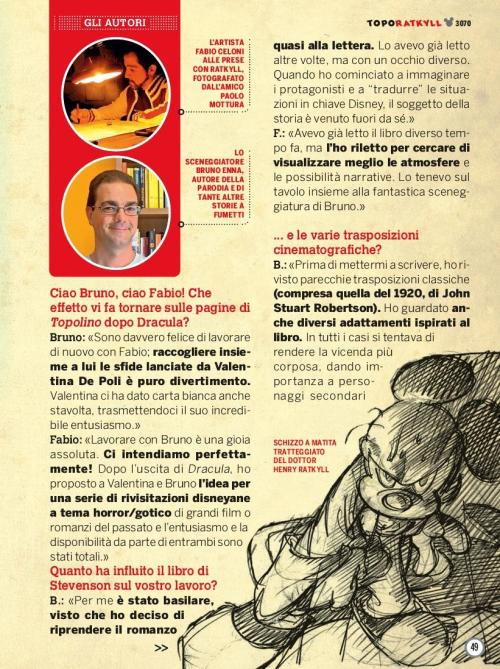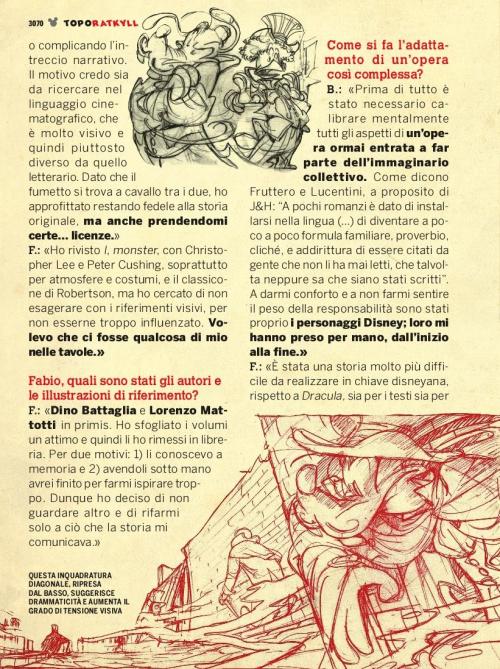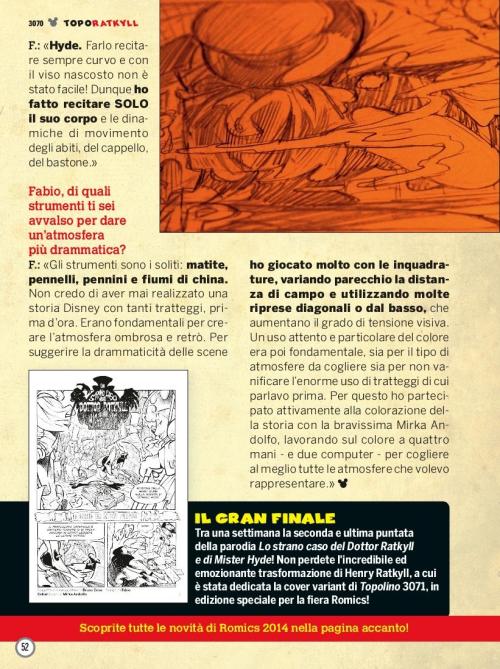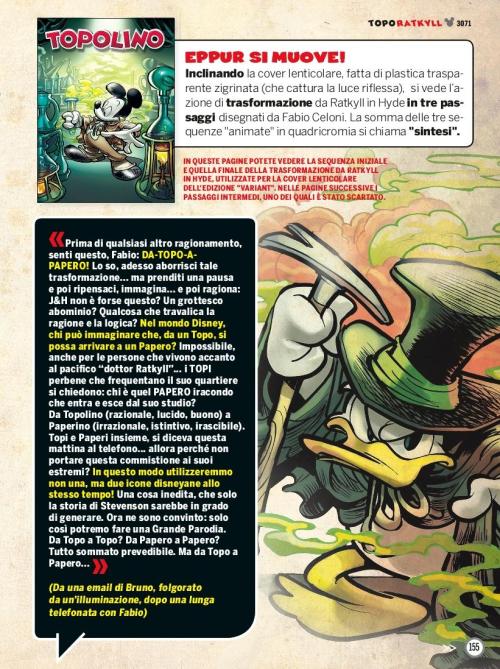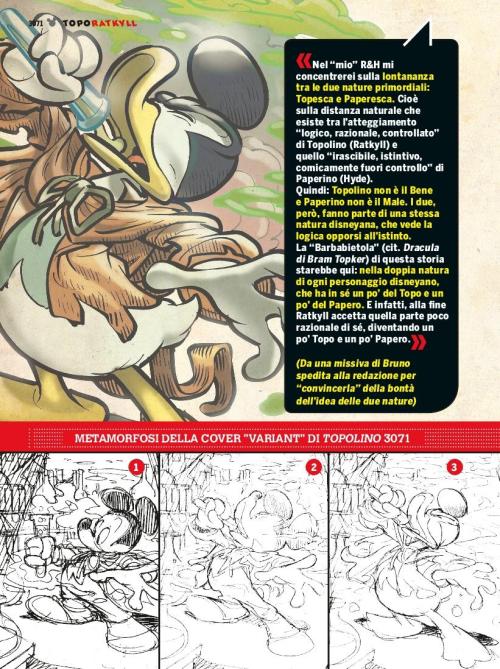esepoimipullula:min-duckfan:min-duckfan:ohhhh there is jekll and hyde parody @frustratedpker scanlat
esepoimipullula:min-duckfan:min-duckfan:ohhhh there is jekll and hyde parody @frustratedpker scanlated them^^♥https://mega.nz/file/jaQXXAgD#TO_cApCyS3GUkhViMLl_qzNzyOmBFnQz7hwEysOj55chttps://frustratedpker.tumblr.com/post/640956678334971904/ratkyll-and-hyde-scanlation-part-2Ratkyll and Hyde scanlation Part 2A translation of the interview to go with (awesome) story! Basically, I love how Bruno Enna sounds like a total mad scientist in his email to Fabio Celoni… so I ended up doing the whole thing while I was at it! :D—–SHIVER AND SHUDDER… IN AWE OF THE AUTHORS!Text by Barbara GarufiAs you wait to read the second episode of RATKYLL AND HYDE on the next number, let’s exchange a dew words with BRUNO ENNA and FABIO CELONI, the creators of this incredible parody…If the story you’ve just read left you with a sense of disquiet that you can’t shake off… well, that means the authors managed to strike the right chords in your souls. Screenwriter Bruno Enna and illustrator Fabio Celoni, paired up once again after the adventure of Dracula di Bram Topker (Topolino nn. 2945 and 2946), give us another powerful story, taking advantage of their professional experience in realistic horror comics, their tendency to the gothic, the supernatural, and the fantastical, and especially, their great Disneyan “sensibilities.” Now, it’s time for the authors to do the talking…Hi Bruno, hi Fabio! What’s it like to come back to Topolino’s pages after Dracula?Bruno: “I’m really happy to work with Fabio again; accepting Valentina De Poli’s challenges together with him is so much fun. This time Valeinta even gave us carte blanche, infusing us with her incredible enthusiasm.”Fabio: “Working with Bruno is an absolute joy! We understand each other perfectly! After Dracula was published, I proposed to Valentina and Bruno a series of Disneyan horror/gothic-themed interpretations of great movies or novels from the past, and the enthusiasm and the willingness from them both was absolute.”How much did Stevenson’s book influence your work?B: “To me, it was fundamental, since I decided to recall the book almost word by word. I’d already read it other times, but with a different outlook. When I started to imagine the main characters and to “translate” the situations in Disney style, the subject of the story came up all by itself.“F: “I’d already read the book some time ago, but I read it again to try and visualize the atmospheres and the narrative possibilities better. I kept it on the table together with Bruno’s screenplay.”… and the various cinematographic adaptations?B: “Before I started writing, I rewatched several classic transposition (including the 1920, by John Stuart Robertson). I also watched a few adaptations inspired from the book. Each of them tried to make the story richer, by giving more importance to some secondary characters or by complicating the storyline. I think one should look for the reason in the cinematographic language, which is very visual and so, quite different from the literary language. Since comic book language stands between them, I took advantage of it, staying faithful to the original story, but also taking certain… liberties.”F: “I rewatched I, Monster with Christopher Lee and Peter Cushing, especially for the atmospheres and costumes, and Robertson’s big ol’ classic, but I tried not to exaggerate with the visual references, to not be too influenced by them.I wanted there to be something of mine in the panels.”Fabio, which authors and illustrations did you take as a reference?F: “Dino Battaglia and Lorenzo Mattotti, first and foremost. I flipped through their volumes for a moment before putting them back on the bookshelf. For two reasons: 1)I already knew them by heart and 2) if I’d kept them nearby I would have ended up too inspired by them. So I decided not to look to anything else and to take inspiration only from what they story told me.”How do you adapt such a complex work?B: “First of all, it was necessary to calculate every aspect of a work that’s become part of out collective imagination. As Fruttero and Lucentini said about J&H: "Few novels are allowed to install themselves in out language (…) to become, little by little, a familiar formula, a proverb, a cliché, and even to be quoted by people who never read them, who sometimes don’t even know who wrote them.” It was the Disney characters themselves who comforted me and didn’t allow me to feel the weight of my responsability; they took me by the hand, from start to finish.“F: "This was a much more difficult story to create in the Disneyan style, compared to Dracula, both because of the script and because of the graphical side of things, because it’s a psychological tale that investigates the complex human inner realities. As usual, Bruno wrote a little gem, something that’s not esay when you’re starting from such a complex and extreme text, speaking in Disneyan terms. I bet it all on the atmospheres and tried to suggest Hyde’s ambiguity in his stooped, lopsided posture, so that he’d radiate darkness all over.”Bruno, why is this story divided in chapters like the original?B: “To stay faithful to the novel, but also to perfect a personal procedure, which I inaugurated with Dracula. It’s a method that’s all about the "way” to stage certain classics, staying as close as possible to the original. Dracula was an epistolary novel, so I put in the script some captions that could remind the reader of that type of narration. While this time, the novel’s peculiarity is in its division in chapters, which subdivides and provides the rhythm of the story, hiding Mr. Hyde’s identity until its final reveal (like in a modern thriller).“And how did you develop the "double personality” theme?B: “I wanted to relaunch the story by really starting from the novel, and having the Disney protagonists "play” the roles of the characters. That’s a journey through the dephts of human mind, in what makes it so complex and fascinating. So I asked myself: what makes the Disney world just as complex and fascinating? Surely, the variety of its stories and the strength of its characters. Mice and Ducks, together: neither of them could exist without the others.“What was the most difficult character to create?B: "Certainly Basettoni [Translator’s note: Chief O'Hara]: he’s the character closest to the Mouse after Goofy and I didn’t want to have him make just a cameo. So I gave Casey the inspector’s role and decided to have O'Hara play the loyal butler, Basetpoole.”F: “Hyde. Having play his part while always staying hunched over and keeping his face hidden wan’t easy! So, I had ONLY his body play the part, together with the dynamics of the movement of his clothes, cloack, and cane.”Fabio, what instruments did you use to create a more dramatic atmosphere?F: “The tools are the usual: pencils, paint brushes, ink pens, and rivers of Indian ink. I don’t think I’ve ever drawn a Disney story with so much hatching, up until now. But it was fundamental to create this shadowy, retro atmosphere. To suggest the gravity of the scenes, I play a lot with the framing, varying the distance a lot and using diagonal shots and shots from below, to heighten the visual tension. A careful and particular use of color was also fundamental, both for the kind of atmosphere to capture and to avoid frustrating the huge use of the hatching technique I was talking about. That’s why I actively took part in the coloration of the story together with the great Mirka Andolfo, working with four hands - and two computers - to better capture all the atmospheres I wanted to represent.”TO BE A MOUSE OR A DUCK?This issue has a “double personality”, just like main character of the fantastic parody you’ve just read! Here’s the “BEHIND THE SCENE” of the “TWIN” COVER, this issue’s lenticular Topolino “variant”, dedicated to the story of Ratkyll and Hyde, in a special edition for Romics 2014…The Strange Case of Dr Jekyll and Mr Hyde is one of the most read and most famous novels in the world. That’s just why, for screenwriter Bruno Enna and illustrator Fabio Celoni, it was a “double challenge” to keep the readers holding their breath, when they already knew the heart of it… meaning, Dr. Jekyll’s prodigious transformation into Mr. Hyde. Let’s discover the secret of their brilliant Disneyan intuition… though the authors’ musings on the theme of the “double nature”, the Mouse one and the Duck one, while following all the sequences that “animated” the “lenticular” variant cover dedicated to the story.AND YET, IT MOVES!By inclining the lenticular cover in transparent knurled plastic (which reflects the light), you can see the transformation from Ratkyll to Hyde in three passages drawn by Fabio Celoni. The sum of the three “animated” sequences in four-colour printing is called “synthesis.”“Before we consider any other line of reasoning, hear me out, Fabio: FROM-MOUSE-TO-DUCK! I know, right now you abhor such a transformation… but take a pausa and then think back on it, imagine… and then, consider: isn’t that was J&H is about? A grotesque abomination? Something that trascends reason and logic? In the Disney world, who could imagine that, from a Mouse, you could get to a Duck? That would be impossible, even for the people living near peaceful "Dr. Ratkyll”… the respectable MICE who hang in his neighbourhood and wonder: who’s that wrathful DUCK who comes and go from his study?From Mickey (rational, clear-headed, good) to Donald (irrational, instinctive, quick-tempered).Mice and Ducks together, we were saying this morning on the phone… then why not bring this mixture to the extreme? This way, we’ll use not just one but two Disney icons at the same time! Something never seen before, which only Stevenson’s story could generate. Now I’m convinced of it: that’s the only way we could create a Great Parody.From Mouse to Mouse? From Duck to Duck? Predictable, all in all. But from Mouse to Duck…“(From an email by Bruno, who got struck by an epiphany after a long phone call with Fabio)"In "my” R&H, I’d focus on the distance between the true primordial natures: the Mouse one and the Duck one. I mean the natural distance that exists between Mickey’s (Ratkyll’s) “logical, rational, controlled” attitude and Donald’s (Hyde’s) “irascible, instinctive, comically out-of-control” one.So: Mickey is not Good and Donald is not Evil. Although, the two of them are part of one same Disneyan nature, that sees logic opposed to instinct.The “Beetroot” (see: Dracula di Bram Topker) [Translator’s note: in Enna’s and Celoni’s Dracula, beetroots and beetroot juice replace blood, while transormation into giant beetroot takes the place of death. Here, Celoni is using “Beetroot” to mean a brilliant idea that allows for the duo take an adult story and make it both suitable for younger readers AND fun, clever, and imaginative] of the story would be in this: in the double nature of every Disney character, who has in themself a bit of Mouse and a bit of Duck. Indeed, in the end Ratkyll accepts that not-so-rational part of himself, becoming a bit Mouse and a bit Duck.“(From a letter by Bruno, sent to the editorial staff to "convince” them of how good the idea of the two nature was) -- source link
Tumblr Blog : min-duckfan.tumblr.com
#oh cool#thanks#long post#mickey mouse#donald duck


